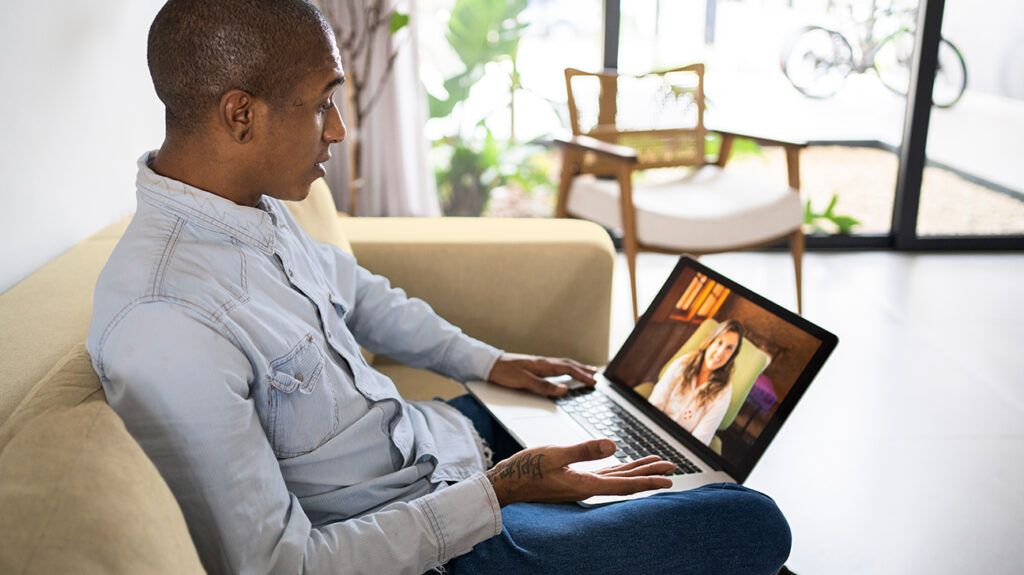With the pandemic creating a new normal, many people are turning to teletherapy. Following best practices for online therapy can help you get the most out of it.

We strive to share insights based on diverse experiences without stigma or shame. This is a powerful voice.
One convenient way to meet with a therapist is through online therapy — also known as teletherapy. These types of sessions allow for physical distancing. You might ask yourself, “What can I do to make therapy most effective for me?”
Teletherapy has many benefits that traditional in-person therapy doesn’t.
One of the most significant benefits of this type of therapy these days is meeting with your therapist without putting yourself or your therapist at risk of getting coronavirus. You can also meet with your therapist from most locations as long as your therapist is licensed in the state you’re in.
In my experience as a licensed therapist who offers online therapy, these five tips may help make the best of your experience.
There are a variety of platforms out there that provide online therapy services. For example, you may choose to find a therapist on your own who offers teletherapy services through a private practice or use an online teletherapy platform such as BetterHelp or Talkspace. Each choice has different benefits and limitations.
Some online therapy platforms may be more affordable than others. You might also try nuanced teletherapy, such as:
Therapists have an ethical duty to conduct their sessions in a private space where confidentiality is protected. You might consider doing the same.
Finding a remote area for your session is best. It’s unwise to start a session in public or where others can come or go.
If you have thin walls, it may be helpful to invest in a white noise machine so other roommates or co-workers can’t hear you. It can also be helpful to buy a door draft stopper that you can slide under or near your door frame to muffle noise.
Limiting distractions helps your therapist to hear you on your virtual sessions and keeps you fully focused on meeting your goals.
If you haven’t been in therapy before, you might wonder what to expect. In addition, engaging in online therapy may bring up other questions such as:
- Who’s responsible for starting the session?
- How long are virtual sessions?
- How far in advance should I expect the virtual access code?
- Are there other confidentiality considerations?
- How will you maintain my confidentiality if there are others in your space?
- How do you communicate with your clients between sessions?
- How should we resolve any technical issues that might occur in our work together?
- Should I expect phone calls or video sessions?
Asking your therapist these questions upfront may provide you with clarity regarding expectations in therapy.
Going to in-person therapy sessions may allow more space to get in the therapy mindset. In contrast, online therapy may present additional challenges in preparing yourself for a session.
For example, a
The author suggests that the online therapist and client also prepare themselves for a mentality that limits outside distractions since the “space” for therapy is different from face-to-face.
For example, with virtual therapy, you might want to turn off notifications on your computer or cellphone and be fully immersed in what’s happening in therapy.
If you’re participating in teletherapy at home, you might need to set some additional boundaries for yourself to help you fully focus on the session. For example, you may:
- wear comfortable but socially appropriate clothing
- avoid starting a session under the influence of substances such as alcohol
- switch to warm, bright lighting so that your face can be seen clearly in virtual meetings
The increase in the availability of online therapy allows mental health care to be more accessible for many people. However, it presents challenges for both the therapist and client alike. It’s OK to tell the therapist that they need to adjust their volume or fix their lighting or video to make sessions more comfortable for you.
It’s also OK to provide your therapist with feedback about the therapeutic relationship. It may be more difficult online to figure out whether your therapist is a good match.
You can let your therapist know if you feel like you aren’t getting anything out of therapy or your goals aren’t being met. It’s also OK to switch therapists if you need to.
Research suggests that teletherapy is a way to access mental health care now and in the future. Preparing for your session can keep you fully engaged in the process.
It may take some trial and error, but these tips can help you adjust to online therapy.